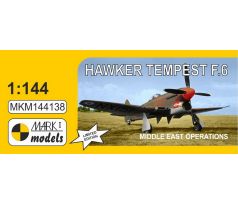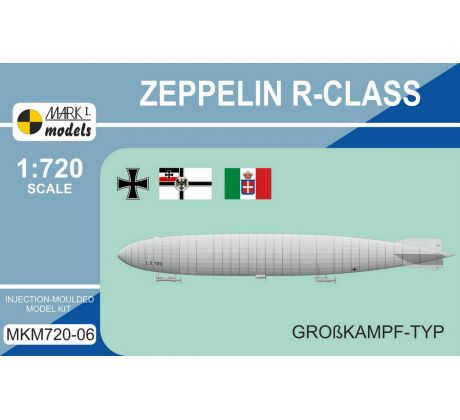Zeppelin R-class ‘Großkampf-Typ’

Zeppelin R-class ‘Großkampf-Typ’
Mark I Model 1:720
This injection-moulded kit contains 49 parts, including a useful model stand. A comprehensive instruction leaflet and a decal sheet are included.
Colour schemes included in the kit:
1) Zeppelin LZ83 (R-class), LZ113, Black LZ113, Airship Troop (Luftschifftruppe), Imperial German Flying Corps (Fliegertruppe des deutschen Kaiserreiches), Seddin bei Stolp Airship Base, Germany, spring 1917
2) Zeppelin LZ87 (R-class), Naval Airship Division (Marine-Luftschiff-Abteilung), Imperial German Navy (Kaiserliche Marine), Ahlhorn Airship Base, Germany, November 1917
3) Zeppelin LZ90 (R-class), LZ120, Black L.Z.120, Airship Troop (Luftschifftruppe), Imperial German Flying Corps (Fliegertruppe des deutschen Kaiserreiches), Seerappen Airship Base, East-Prussia, Germany, July 1917. In August 1917 handed over to Naval Airship Division (Marine-Luftschiff-Abteilung), Imperial German Navy (Kaiserliche Marine).
4) Zeppelin LZ90 (R-class), ex-LZ120, Black ‘Ausonia’, Italian Army, Ciampino Air Base, Italy, spring 1921
| Ref. No.: | MKM720-06 |
| Availability: | IN STOCK |
Zeppelin R-class ‘Großkampf-Typ’
Description
Rigid airships (or dirigibles) were produced and relatively successfully employed in the period from the early 1900s to the end of the 1930s.
During WWI the Zeppelin company, of Imperial Germany, built nearly one hundred military airships both for their army and naval corps. The airship type and construction was characterised by particular class (A to X). During The Great War they were used as a new type of attack weapon for bombing and also for reconnaissance and naval patrol work.
The Zeppelin R-class airship was developed in 1915-16 and consisted of structural metal framework covered in doped fabric containing cells filled with a hydrogen lifting gas. They were fitted with vertical tailfins and horizontal tailplanes with control surfaces. The crew members were carried in two suspended gondolas (cars) mounting Maybach engines and pusher propellers, while bombs were contained in internal bomb bays. Defensive gunners were stationed in the front upper part of the airship’s body, in an aft gun position behind the rudders, two in gondolas and in each of the cars either side of the hull. In total, 17 R-class airships were built.
Last seen productsCancel history

Tempest F.6 'Middle East Operations'
Description: This injection-moulded kit (one model is included) contains 37 parts, 3 resin parts (the wing, the radiator and a Pitot tube) and one clear part (the cockpit canopy). A comprehensive decal sheet is included.
Colour schemes included in the kit:
1) Hawker Tempest F Mk.6, NX129, Sky JV-D, No.6 Sq., Royal Air Force, RAF Station Khartoum, Sudan, spring 1948
2) Hawker Tempest F Mk.6, NX143, Red GN-H, No.249 'Gold Coast' Sq., Royal Air Force, Habbaniya Air Base, Iraq, 1947
3) Hawker Tempest F Mk.6, NX151, White E, No.213 'Ceylon' Sq., Royal Air Force, RAF Station Deversoir (Abu Sultan), Egypt, 1949
4) Hawker Tempest F Mk.6, NX135, Black V, No.6 Sq., Royal Air Force, detachment at RAF Station Nicosia, Cyprus, early 1949






